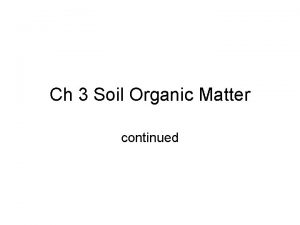The Influence of Juncusrhizosphere Dissolved Organic Matter on

- Slides: 1

The Influence of Juncus-rhizosphere Dissolved Organic Matter on Coastal Plankton Communities BRITTANY N. ZEPERNICK, 1, 2 JEFFREY W. KRAUSE 2, 3 AND BEHZAD MORTAZAVI 2, 4 1 Bowling Green State University, 2 Dauphin Island Sea Lab, 3 University of South Alabama, 4 University of Alabama Correspondence: brittzepernick@gmail. com, jkrause@disl. org, bmortazavi@ua. edu V. Conclusions IV. Results I. Introduction Initial DOC and DON Concentrations • Juncus roemerianus releases significant dissolved organic matter (DOM) within its rhizosphere. • We predict this DOM is labile, and will increase net phytoplankton production and bacterial production. 600, 0 500, 0 400, 0 300, 0 200, 0 100, 00 DON (µM) Subsurface water movement (e. g. submarine groundwater discharge, tidal flux) and sediment benthic flux can move rhizosphere DOM into the water column. DOC (µM) • DOC General respiration Stoichiometry: 20, 00 Salinity (psu) 40, 00 30, 00 25, 00 20, 00 15, 00 10, 00 5, 00 0, 00 (CH 2 O)106(NH 3)16(H 3 PO 4) +138 O 2 106 CO 2 + 16 HNO 3 + H 3 PO 4 +122 H 2 O 10, 00 20, 00 30, 00 40, 00 Salinity (psu) Pennock et. al. 1989, 1990, 1999 Sample Salinities: 31. 02 & 32. 45 psu • Treatment Chlorophyll Concentration (±Stdev) • The following metrics will be used to test this hypothesis: - Chlorophyll a (phytoplankton) - Oxygen consumption (bacteria) Sample 1 Sample 2 • • In DOM treatment, 19. 8 µmol/L DOC added O 2 consumption in DOM: 18 µmol/L more than in controls after 24 hrs Suggests 23 µmol DOC consumed … over 100% of DOC addition In Sample 3, Chlorophyll increase was observed after 48 hr period. Sample 3 Figure 1: Juncus rhizosphere pore water collection. II. Field Collection • • Figure 5: Flow. Cam Image Locations of Sample Collection: -Gulf Shores Pier: 30. 247°N, 87. 668°W (Sample 1, 2) -Mobile Bay: 30. 440°N, 88. 998° W (Sample 3) 300 200 100 0 -100 Diameter ESD (µm) Treatments (triplicate bottles): Control, DOM, Labile (C 6 H 12 O 6+ [(NH 4)2 SO 4]) 400 Quantity/Magnitudes of Treatments: DOM Treatment: Extracted using Dittmar et al. (2008, doi: 10. 4319 /lom. 2008. 6. 230) +19. 8 µM DOC addition + 0. 5 µM DON addition • 0 24 48 Time (hrs) 72 0 50 50 40 40 30 20 10 0 0 Labile Treatment (i. e. Positive Control): +1, 000 µM Glucose (C) addition +20 µM Ammonium (N) addition 12 1, 2 1 0, 8 0, 6 0, 4 0, 2 0 Width (µm) III. Methods 500 Circularity (Hu(4 x π x Area) / Perimeter 2) Number of Particles Per m. L Figure 2: Sample Collection Locations. Sample 1, 2, Gulf Shores Pier. Sample 3, Mobile Bay. 12 24 48 Time (hrs) 72 • Juncus roemerianus rhizosphere DOM appears to be very labile, i. e. rapidly consumed by the heterotrophic community. • DOM stimulation of Chlorophyll only observed in Mobile Bay discharge station (Sample 3). • Flow. Cam image diagnostics (sample 3) did not suggest a shift in phytoplankton community structure, despite increased chlorophyll. • DOM is directly labile to phytoplankton community or made accessible after remineralization by the heterotrophic community. 30 20 10 VI. Future Directions 0 72 0 12 24 48 Time (hrs) 72 It remains to be determined if pore water DOM is either directly labile to phytoplankton community or made accessible after remineralization by the heterotrophic community. Future directions include: • • • Conduct more experiments using Mobile Bay water. Assess Prokaryote abundance and diversity. Determine composition of DOM using high-resolution liquid chromatography mass spectrometry. Oxygen (µelectrodes) 250 200 150 100 50 0 10 20 30 Time (hrs) 40 50 60 Linear Regressions Labile [O 2] = -3. 80(time) + 193. 80 R 2= 0. 99 Figure 3: Collection of DOM from pore water utilizing Bonding Agilent Eluts (PPL) • Respiration as a Function of Time Sample 3 0 Figure 4. Environmental incubation system containing samples Figure 7: Flow. Cam Image “Take Home” Points: Flow Cam Quantitative Data (Sample 3 Only) Sample Intervals: 0, 12, 24, 48 & 72 hrs (Figure 3). Sample Analysis: -Chlorophyll a (acetone extraction) -Dissolved Oxygen (optical method) - Fluorescent particle imaging (Flow. Cam) Figure 6: Juncus Rhizosphere water sampling DOM: [O 2] = -1. 52(time) + 190. 01 R² = 0. 99 Control: [O 2] = -1. 29(time) + 194. 09 R² = 0. 91 Acknowledgements Dauphin Island Sea Lab (DISL) personnel: Rebecca Pickering. Turner, Liesl Cole, Israel Marquez, Sydney Acton, William Dobbins, Laura Linn, Alice Kleinhuizen, and Claire Derby for laboratory and logistical support. This work was funded by the National Science Foundation (OCE-1358873, DISL REU).

